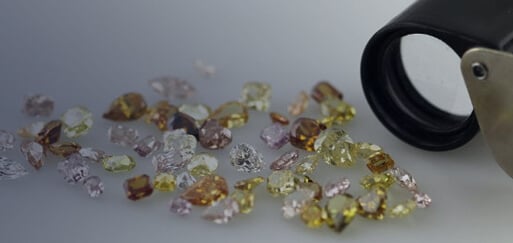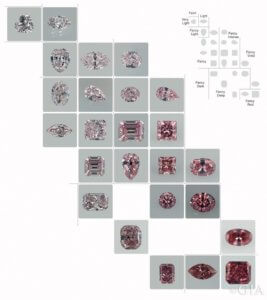When it comes to pricing a diamond, there are many factors at play. We’ve all heard of the 4Cs, which are used to define a diamond’s rarity and value. Although there are now new ways to measure and grade a diamond’s beauty, such as light performance, there’s more to consider when defining a colored diamond.
When it comes to fancy colors, there is a whole other set of rules that must be applied. Essentially, it boils down to this: for white diamonds, a key factor is a colorless appearance. For colored diamonds, it’s all about the depth of the color.
White Diamonds: Not White, Colorless
White diamonds are not really “white”. White diamonds are in fact lacking in color - they are ‘colorless’, like water. True colorless diamonds are quite rare. Most white diamonds have a natural tinge. This can be seen clearly in the standard color grading scale, where D denotes a pure, colorless appearance, through to Z, which denotes a strong yellow tinge.
White diamonds with low color grading, meaning they are yellowish in tone, are not considered as rare or valuable as colorless white diamonds. Of course, color is just one of the ways that a diamond is valued. If a low color diamond has excellent cut and clarity, it will be valued higher. Yet overall, a white diamond with a high color grade is much more prized for its appearance than a yellowish looking, low color-graded white diamond.
Colored Diamonds: Shades of Beauty
Fancy color diamonds come in a palette of shades, from the more common browns and yellows, to the highly rare pinks, blues, greens and even reds, which - due to their rarity - are more expensive than white diamonds.
The more common fancy colors, such as yellow and brown, tend to be less valuable. Until recent years, brown diamonds were not deemed gem quality, and were used only for industrial purposes. Today, brown diamonds, renamed and rebranded by Le Vian as ‘Chocolate Diamonds’, have found a market among diamond jewelry consumers.
Of course, it’s not just the color that impacts the diamond’s value. Carat weight, shape and cut are also key. And when it comes to fancy color diamonds, there are other important factors to consider, namely ‘hue’ and ‘saturation’.
Hue & Saturation: The Markers of Colored Diamonds
Colored diamonds occur due to the presence of various chemicals during the long formation process deep in the earth. Depending on a range of geological and chemical factors, colored diamonds take on a particular hue, or color, and a certain level of color saturation, or intensity. The stronger the saturation, the more intense and rich is the color of the fancy diamond.
There are various ways to define a diamond’s saturation level, or intensity of color. These include:
- Faint
- Very Light
- Light
- Fancy Light
- Fancy
- Fancy Intense
- Fancy Dark
- Fancy Deep
- Fancy Vivid
This is illustrated by the GIA’s famous guide to fancy color diamonds, displayed here in various color saturations of pink:
Fancy color diamonds are continuing to rise in price, showing a 70% increase in price in the last decade. Yet, there are price differences between the various colors too. In the third quarter of 2018, pink diamond prices rose 0.4%, while fancy blues outshone all others with a value increase of 8.5%.
The Eternal Competition
Take a look at the top 10 most expensive diamonds of all time, and you will see that in the realm of colored versus white diamonds, it’s a tough competition. Of course, large, excellent quality fancy color diamonds will naturally come with a hefty price tag; this is largely due to their incredible rarity. But there is no doubt that some of the world’s most coveted white diamonds, which are a part of our popular culture and tradition, are also worthy of taking center stage in the diamond stakes.
So which diamond is the winner in the war of colored versus white? While fashion trends may sway with the times, rarity versus availability is an important factor too. With so many criteria to consider, for many consumers, it all comes down to personal taste, preference and budget.





-1.jpg?width=310&name=blog_image%20(003)-1.jpg)





